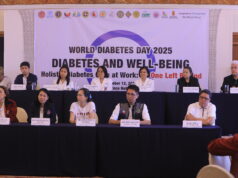Medicine Cabinet
By Reiner W. Gloor
THE number of Filipinos dying due to liver cancer may double in the coming years from the present average figure of 20 deaths per day, according to health research statistics. Estimates from the 2014 studies of the International Agency for Research on Cancer for the Philippines placed liver cancer as the 3rd leading cause of cancer-related deaths in the country. Liver cancer is the 2nd leading cause of death among male Filipinos and 5th among female Filipinos.
The US Centers for Disease Control and Prevention (CDC) estimates that about 80% to 95% of all liver cancer cases are related to the Hepatitis B or Hepatitis C viruses. In the US, more than 4 million people are living with chronic Hepatitis B or chronic Hepatitis C. Most don’t know they have the virus.
The risks for liver cancer may be lowered by getting vaccinated against Hepatitis B, getting tested for Hepatitis C, and avoiding too much alcohol consumption. We must avoid several behaviors and conditions that may lead to higher risks of getting liver cancer. Heavy alcohol use may cause cirrhosis — or the scarring of the liver — which can also be caused by hepatitis. The same is true for cigarette smoking.

The intake of too much iron leads to hemochromatosis, a condition where the body stores more iron than it needs. When eating grains or nuts, and other food items, please check carefully for aflatoxin, a fungus that can grow on food items that have not been stored properly.
In its early stages, the CDC said liver cancer may not have symptoms that can be seen or felt. However, as the cancer grows larger, people may notice one or more common symptoms. It is important to remember that these symptoms could also be caused by other health conditions. Symptoms may include discomfort in the upper abdomen on the right side; a swollen abdomen; a hard lump on the right side just below the rib cage; pain near the right shoulder blade or in the back; jaundice, or the yellowing of the skin and whites of the eyes; easy bruising or bleeding; unusual tiredness; nausea and vomiting; loss of appetite; and weight loss for no known reason.
Liver cancer risks can be lowered in the following ways:
• Vaccination against Hepatitis B infection. The Hepatitis B vaccine is recommended for all infants at birth and for adults who may be at increased risk.
• Test to find out if one has Hepatitis C.
• Avoidance of alcohol and tobacco products. Smoking can cause cancer almost anywhere in the body, including the liver.
The World Health Organization (WHO) said that the global problem and burden of Hepatitis B and C are “alarming.” It is estimated that about 500 million people, globally, are chronically infected. In countries in the Western Pacific Region (which includes the Philippines) Hepatitis B and C are transmitted through birth, blood, or unprotected sex. Also in the Western Pacific Region, many people become chronically infected by Hepatitis B through mother-to-child transmission and contact with infected blood. It is also estimated that 80% to 90% of infants develop chronic infections during the first year of life. But these chronic infections can be prevented by proper and timely immunization.
Immunization is one of the major tools in the list of strategies employed by the WHO for its cost-effective interventions to prevent and control non-communicable diseases like liver cancer. Under the Philippine immunization requirements, each infant must be administered the birth dose of Hepatitis B vaccine within 24 hours, and two other shots after six and 14 weeks.
However, there is one major problem in meeting the Philippine immunization requirements: the birth dose is not given because about 40% of babies are delivered at home, maternal and child experts observed. The Department of Health said that deliveries spawn “missed opportunities” as only a small number of skilled birth attendants are able to assist home deliveries and bring with them Hepatitis B vaccines. It is still advisable that all Filipino babies be delivered in a proper birthing facility run or administered by professional health care personnel.
Log on to www.phap.org.ph and www.phapcares.org.ph.
E-mail the author at reiner.gloor@gmail.com.



